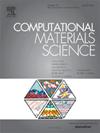单轴载荷下Fe/TiN界面错配位错网络与力学行为
IF 3.3
3区 材料科学
Q2 MATERIALS SCIENCE, MULTIDISCIPLINARY
引用次数: 0
摘要
氮化钛(TiN)作为铁素体钢力学性能的增强相,其Fe-TiN界面的特性和变形机理起着关键作用。在本研究中,采用分子动力学模拟研究了实验中观察到的具有晶体取向关系(ORs)的四个具有代表性的Fe/TiN界面。结果表明,强Fe-N键对界面能和粘附功有显著影响,特别是对n端界面。利用界面失配分析和原子信息Frank-Bilby方法,我们表征了错配位错网络(MDN)结构,详细描述了位错线方向、间距和Burgers向量等特性。与NbC/Nb接口相比,Baker-Nutting OR界面的MDN结构模式相同,而Nishiyama-Wasserman和Kurdjumov-Sachs OR界面的MDN结构与其他fcc/bcc接口不同。这些差异是由Fe-N键和Fe-Ti反键的协同作用引起的。此外,在T=300K时对Fe/TiN双晶施加拉伸和压缩载荷。分析表明,MDN结构内的交叉点是Fe层中晶格位错的成核位点。应变场分析进一步确定这些交叉点为高应变区,促进位错成核/发射。本文章由计算机程序翻译,如有差异,请以英文原文为准。

Misfit dislocation network and mechanical behaviour of Fe/TiN interface under uniaxial loading
Titanium Nitride (TiN) functions as a reinforcement phase that enhances the mechanical properties of ferritic steels, with the characteristics and deformation mechanisms of the Fe-TiN interface playing a pivotal role. In this study, molecular dynamics simulations were employed to investigate four representative Fe/TiN interfaces with crystallographic orientation relations (ORs) observed in experiments. The results reveal that strong Fe-N bonding significantly affects the interface energy and work of adhesion, particularly for N-terminated interfaces. Using interface disregistry analysis and atomistic informed Frank–Bilby approach, we characterized the misfit dislocation network (MDN) structures, detailing properties such as dislocation line orientation, spacing, and Burgers vector. The MDN structure of interface with Baker-Nutting OR shows the same pattern compared with NbC/Nb interface, while Nishiyama-Wasserman and Kurdjumov-Sachs ORs show different MDN structure compared with other fcc/bcc interfaces. These differences arise from the synergistic effects of Fe-N bonding and Fe-Ti anti-bonding. Additionally, tensile and compressive loads were applied to the Fe/TiN bicrystals at . The analysis indicates that intersections within the MDN structure serve as nucleation sites for lattice dislocations in the Fe layer. Strain field analysis further identifies these intersections as highly strained regions, facilitating dislocation nucleation/emission.
求助全文
通过发布文献求助,成功后即可免费获取论文全文。
去求助
来源期刊

Computational Materials Science
工程技术-材料科学:综合
CiteScore
6.50
自引率
6.10%
发文量
665
审稿时长
26 days
期刊介绍:
The goal of Computational Materials Science is to report on results that provide new or unique insights into, or significantly expand our understanding of, the properties of materials or phenomena associated with their design, synthesis, processing, characterization, and utilization. To be relevant to the journal, the results should be applied or applicable to specific material systems that are discussed within the submission.
 求助内容:
求助内容: 应助结果提醒方式:
应助结果提醒方式:


